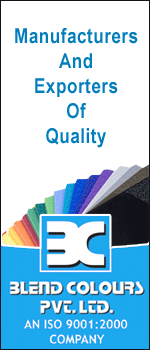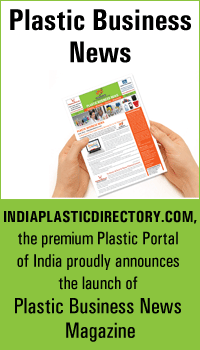|
Polypropylene The invention of PP was
nearly simultaneous in the U.S. and Europe. Today, PP is the largest volume
commodity thermoplastic. The American Plastics Council (APC) pegs North American
PP consumption last year at 16.446 billion lb. This compares with 6.438 billion
lb for LDPE, the only polyolefin that existed prior to 1955.
In 1953, Prof. Giulio Natta at Milan Polytechnic in Italy further developed the
breakthrough of that same year by Prof. Karl Ziegler at the Max Planck Institute
for Coal Chemistry in Germany. Prof. Ziegler discovered that titanium
tetrachloride could catalyze stereospecific polymerization of polyethylene. With
financial aid from Montecatini (later Montedison), a large Italian chemical
company, Prof. Natta extended Prof. Ziegler�s discovery to the development of
isotactic PP, which Montecatini was the first to produce on an industrial scale
in 1957 in its Ferrara plant. At NPE 1956, Montecatini exhibited PP film and
monofilaments.
Two of the first major applications for PP were monofilament (below) and
bi-oriented film for bread wrap and other packaging. (Photos: Enjay
Laboratories, U.S.I.)
In the U.S., meanwhile, Paul Hogan and Robert Banks of Phillips Petroleum (now
Chevron Phillips) were experimenting with high-octane gasoline when they
discovered high-melting crystalline PP in 1952. Phillips did not start
commercial production of PP until the early �60s. The first commercial producer
in the U.S. was Hercules Powder Co. (bought by Montedison and ultimately part of
Basell) in 1958. Others quickly followed.
By NPE 1958, PP homopolymers were available from Hercules, Chemore, Spencer
Chemical (marketing for Exxon), and Capac Plastics. Besides Montecatini, Hoechst
in Germany and ICI in England were bringing on commercial capacity. Avisun Corp.
soon after was producing PP homopolymer and random copolymer at New Castle, Pa.
Although Montecatini was first to make both random and impact copolymers, Avisun
introduced the first impact copolymers in the U.S. at NPE �61, with Hercules and
others soon to follow. Avisun was acquired by Amoco in 1967.
Among the very first commercial PP applications were monofilaments for fabrics,
carpets, and ropes, as well as clear, biaxially oriented (BOPP) films used as
replacements for cellophane in cigarette wrap, bread wrap, and retail packaging
for shirts and other garments. Closely following in the late 1950s and early
�60s were extruded pipe, strapping, drinking straws, and wire/cable coatings.
One of the first injection molded products was a two-piece bed pan. This was
followed by a variety of electrical parts, washing-machine tubs and impellers,
hypodermic syringe barrels, medicine bottles, and food containers. A big
breakthrough was the screw cap with a living hinge for Seagram�s liquor bottles.
This essentially knocked polystyrene out of the closure business and led the way
for PP into all types of consumer bottle caps.
A breakthrough application for molded PP was the first washing-machine
agitator�this 3-lb unit was molded for Kelvinator by American Motors� Evart
Products Co. on a 1200-ton, three-stage plunger machine with preplasticator.
By the early 1960s, PP and its copolymers were being used in several automotive
applications. This included the use of impact copolymers for battery cases and
fender liners, random copolymers for washer-fluid reservoirs, and filled
homopolymers for air-intake and heater ducting. Impact copolymers were soon used
for auto door interior trim and liners, as well as dashboards. There is
currently an average of more than 50 lb of PP used in an automobile.
In the late �60s, blow molded containers, such as bottles for detergents, food,
shampoos, and other liquids, made a splash. The first was for Procter & Gamble�s
Dawn dish soap in 1967, which initially was made by the Phillips Orbet extrusion
stretch-blow molding process, made obsolete a decade later by PET injection
stretch-blow molding. PP�s impact resistance and ease of blow molding soon
spawned applications such as ice chests, water coolers, housewares, toys,
furniture, appliance housings, dairy containers, and snack-food packaging (metalized
BOPP film).
HDPE ( High Density Polyethylene )
The invention of the low-pressure process to make HDPE took place in both the
U.S. and Europe at nearly the same time and centered around the development of
types of catalysts that promoted ethylene polymerization at milder temperatures
and pressures than were (and still are) used for LDPE.
The Hula Hoop craze of 1957, based on a circular tube of HDPE, sparked the
development of HDPE pipe. (Photo: Chevron Phillips)
The first of these new catalysts was discovered in 1951 by Robert Banks and John
Hogan at Phillips Petroleum (who were also pioneers in PP polymerization). In
1953, Prof. Karl Ziegler at Germany�s Max Plank Institute for Coal Chemistry
developed another low-pressure/low-temperature catalyst system. By the late
1950s, both methods were being used for HDPE production. In Europe, the first
full-scale low pressure HDPE plant was erected by Farbwerke Hoechst AG in late
1955. Plastics Technology reported in September 1955 that Hoechst�s Hostalen
resin, with a density of 0.94 g/cc, was the talk of the Hanover Industrial Fair
in Germany, where it was shown for the first time in applications such as film,
pipe, tubing, and molded household articles.
In the U.S., Phillips produced the first commercial HDPE (0.963 density) under
the Marlex tradename in the summer of 1956, although it had provided pilot plant
quantities as early as 1955. At NPE 1958, commercial HDPE resins were featured
by Celanese, Phillips, Spencer Chemical (marketing for Exxon), and W.R. Grace.
These suppliers highlighted the potential of blow molded rigid HDPE for
replacing glass containers. Other early suppliers to follow included Hercules,
Koppers, and Dow.
Among the earliest products were extrusion blow molded bottles for bleach and
detergents, baby bottles, and injection molded housewares, such as the famous
Tupperware containers.
Baby bottles were one of the first applications for HDPE. (Photo: Chevron
Phillips)
One of the largest volume applications emerged in an unexpected way in 1957,
when the Hula Hoop, an extruded tube bent into a circle, became a fad among
teenagers throughout the U.S. and abroad. Wham-O, which trademarked the Hula
Hoop name and was its most successful manufacturer, produced the toy using
Phillip�s Marlex HDPE. It was this fad that led to large-volume manufacturing of
extruded HDPE pipe for high-performance applications such as natural-gas
distribution, handling mine tailings, and sewer lines.
Use of blow molded HDPE bottles grew far beyond detergents and bleach to include
shampoos, motor oil, drug and cosmetic products, water, and milk. Milk bottles,
in fact, are the single biggest volume HDPE package. Other large-volume
applications are ice chests, beverage coolers, jerry cans, trash cans, storage
drums, auto fuel tanks, injection molded food containers (e.g., for margarine
and yogurt), and wire/cable coatings�including trans�oceanic cables.
Meanwhile, high-molecular-weight (HMW) HDPE made its impact in the film market a
bit later. In 1979, Sonoco tested the shopping/grocery bag potential of HMW-HDPE.
At NPE �88, HDPE blown film lines were a highlight.
The American Plastics Council (APC) figures North American HDPE consumption in
2004 at 15.264 billion lb, making it the second-largest volume commodity
thermoplastic after PP.
The modern era of engineering thermoplastics was launched in 1953 when Dr.
Hermann Schnell of Bayer AG in Germany and Dr. Daniel W. Fox of GE Plastics in
Pittsfield, Mass., independently discovered the versatile engineering resin
called polycarbonate.
In the 1980s, optical discs became a huge new market for PC. (Photo: Bayer
MaterialScience)
Fox was conducting a series of experiments while working to develop a new wire
insulation material when he found himself with a transparent substance that
hardened in a beaker. That marked the beginning of GE�s Lexan polycarbonate
business. Schnell discovered polycarbonate while working on aromatic derivatives
at Bayer�s main lab in Uerdingen, Germany. As result, the company�s Makrolon PC
business was born. Both companies began to commercially produce PC in 1958. (It
was first reported in the New Materials section of Plastics Technology in
December of that year.)
The first commercial production of bisphenol-A (BPA), an important feedstock for
PC, was a turning point. BPA was first made for epoxy resins but its reaction
with phosgene made commercial production of PC possible.
Architectural glazing is an important market for clear, impact-resistant PC
sheet. (Photo: GE Plastics)
Polycarbonate today is one of the most widely used engineering thermoplastics in
the world. It has found extensive use in business equipment, automobiles, and
telecommunications products. Polycarbonate was first used for electrical and
electronic applications such as distributor and fuse-box covers and later was
extruded into sheet and used as glazing for greenhouses and other architectural
applications. In the 1980s, polycarbonate�s clarity, light weight, and impact
resistance made it the ideal replacement for glass in automotive headlamps. For
car makers, the use of PC brought vast new potential for front-end design.
Another breakthrough application came in 1982 with the introduction of the
compact disc with PC as the substrate. Other major applications include 5-gal
water bottles, cell phones, eyeglass lenses, DVDs, and bullet-proof glazing.
Today, the PC market is growing about 8% annually and total global consumption
is about 5.4 billion lb/yr.
ABS Resins
The addition of butadiene rubber as a third monomer to styrene-acrylonitrile
resulted in development of a new range of widely used thermoplastics called ABS.
Marbon (later Borg-Warner Chemicals and then GE Plastics), Monsanto, and Union
Carbide were key developers of the technology in the 1950s but Marbon emerged as
the leading supplier. In 1954, Marbon launched Cycolac ABS resin and in 1958 a
$12-million plant was commissioned in Washington, W.Va. By 1962, Marbon was
selling about $1 million worth of ABS a month.
Because the three-monomer system could be tailored to yield different balances
of properties, ABS grew to become the largest-volume engineering thermoplastic.
ABS served as a bridge between commodity plastics such as PE and PS and higher
performance materials such as polycarbonate and nylon.
Initially, the big-volume breakthrough applications were the RCA portable radio
and Western Union telephone handset. By 1961, ABS had launched a major assault
on phenolics and cellulosics in phone handsets. Other successes included
appliances, computer and office-equipment housings, lawn-mower housings, safety
helmets, luggage shells, pipe, and fittings.
World consumption of ABS amounted to approximately 12.1 billion lb in 2004, with
Asia accounting for almost 70%. Major markets include appliances and
electrical/electronic parts, with lesser use in autos and recreational vehicles,
pipe and fittings, and miscellaneous consumer products. The top ten ABS
producers in the world�Chi Mei of Taiwan, LG Chemicals of Korea, GE Plastics,
BASF, Lanxess, Cheil in Korea, Formosa Plastics in Taiwan, Dow, Grand Pacific in
Taiwan, and Techno Polymer in Japan�accounted for 74% of world capacity,
according to SRI.
PET ( Polyethylene Ethylene Tere Phthalic Acid)
PET was invented in 1941 by ICI in the U.K. and played its first role as a
fiber, and its second as film with DuPont�s introduction of Mylar in 1952. It
took more than 20 years for PET molding grades to come onto the scene. When they
did, they revolutionized the packaging industry with oriented bottles.
In 1973, DuPont�s Nathaniel Wyeth patented the oriented PET beverage bottle.
Because DuPont lacked solid-state PET resin production, its initial efforts to
produce bottle preforms were unsuccessful, owing to insufficient intrinsic
viscosity (I.V., a measure of molecular weight). The first commercial production
of PET resin suitable for injection molding preforms came from Goodyear in 1974,
which had solid-state capability in place. Between 1976 and 1978, three other
suppliers�Celanese, American Hoechst, and Eastman�brought on PET bottle-resin
capacity
At NPE 1979, Eastman Chemical introduced �spruce green� bottle-grade PET resins
so that plastic bottles could match the color of glass bottles. In the early
1980s, CPET (crystallized PET) arrived as a highly heat-resistant material for
thermoformable, dual-ovenable food trays for prepackaged meals and entrees. At
NPE 1991, amorphous PET (APET) resins for extrusion blow molding of handleware
were introduced by Eastman, DuPont, and Goodyear. APET did not take off, as the
market found it too costly because of the thicker walls required. More
successful was a glycol-modified amorphous PET, called PETG, introduced by
Eastman in 1977. It has been successful in injection and blow molded containers
and extruded sheet and profiles.
The current U.S. PET resin market is approaching 7 billion lb/yr. PET dominates
the soda and �premium� water bottle market for 2-liter and smaller bottles,
where handles are not required.
In 1978, DuPont�s Rynite introduced glass-reinforced PET engineering compounds
for injection molding. (Photo: Rynite coil form)
Engineering PET compounds
Glass- or mineral-filled PET was introduced by DuPont in 1978. Rynite PET
constituted the first �engineering� grade of PET for general-purpose injection
molding. It overcame the limitations of previous reinforced PETs, which were
difficult to mold and suffered poor surface quality, brittleness, and warpage.
Many of the earliest applications were electrical parts, such as coil forms,
automotive ignitions, transformer housings, terminal blocks, motor end brackets,
fuse caps, and light housings. Some other applications in Rynite�s first decade
were chair shells and arms, bicycle drive parts, and boat propellers. Within
five years, Rynite had at least four domestic competitors and at least 15 by the
end of the 1980s.
PBT was first in molding
PBT for injection molding was first brought to the market in 1969 by Celanese,
with its Celanex 3300, a 30% glass-filled grade. In 1972, GE introduced both
unreinforced Valox PBT and a 30% glass-filled grade. Not long after, GE launched
flame-retardant grades. By 1977, Eastman, GAF, LNP, and Thermofil had entered
the business, with Fiberfil and Mobay not far behind.
The earliest PBT applications were in the electrical/electronic connectors,
switches, controls, and automotive high-energy ignition systems. PBT also played
a major part in the development of plastic automotive bumper systems. GE alloyed
PBT with PC to produce Xenoy, a material with high impact strength at low
temperatures plus heat and chemical resistance that enabled all-plastic
auto-bumper systems to replace steel. The 1984 Ford Taurus/Mercury Sable were
the first cars to utilizes this system in both front and rear bumpers.
Chemical Blowing Agents
Despite early experiments with sodium bicarbonate�ordinary baking soda�the era
of foamed plastics had to await the results of German work on hydrazine-based
rocket propellents during World War II. Information on these azo compounds
leaked out to Uniroyal in the U.S., so that by 1950, both this company and Bayer
in Germany were using exothermic blowing agents in rubber.
Uniroyal commercialized its blowing agents under the Celogen name. They were
based on hydrazine, hydrazide, or azodicarbonamide. The last became one of the
most widely used exothermic chemical blowing agents (CBAs) for plastics. One of
its first big uses was PVC plastisol flooring in the late 1950s to early 1960s.
Another, which developed in the mid-�60s, was low-density crosslinked LDPE
foams. Applications included cushioning materials for car door interior panels
as well as packaging and athletic equipment padding. Injection molded PS, ABS,
and PP foams also originated in the mid-�60s using azo CBAs.
A major early extrusion application in the early to mid-1970s was telephone wire
and cable insulation, primarily of foamed HDPE. In the mid-1970s, structural
foam�HIPS, HDPE, PP, and ABS�began to become prominent. Initially, structural
foam makers had used direct injection of nitrogen gas, but that required a
costly license and specially modified equipment. The availability of chemical
blowing agents allowed all molders, including smaller ones, to produce both
small and large parts economically.
Use of CBAs for rotomolding foamed parts began in the early 1980s. About that
time, interest in foamed TPEs for soft-touch applications took off. Activated
azos with reduced initiation temperatures were among those used.
In 1984, CBAs of the endothermic variety came to the U.S. from Europe. The first
was Hydrocerol from Germany�s Boehringer Ingelheim (now a product of Clariant
Masterbatches.) Ironically, they were based on sodium bicarbonate plus citric
acid. These products were less sensitive to loading levels and were said to
produce finer cell structures and smoother surfaces. Also, endothermics were
�cleaner,� producing only CO2 and water, and left no deposits on screws or
molds. Faster degassing of parts was also claimed, and they contributed less
color to foamed parts.
|


 Plastics Engineering
Plastics Engineering


 Knowledge Base
Knowledge Base

















 Knowledge Base
Knowledge Base


